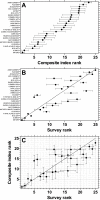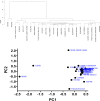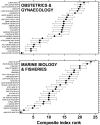How to Rank Journals
- PMID: 26930052
- PMCID: PMC4773013
- DOI: 10.1371/journal.pone.0149852
How to Rank Journals
Abstract
There are now many methods available to assess the relative citation performance of peer-reviewed journals. Regardless of their individual faults and advantages, citation-based metrics are used by researchers to maximize the citation potential of their articles, and by employers to rank academic track records. The absolute value of any particular index is arguably meaningless unless compared to other journals, and different metrics result in divergent rankings. To provide a simple yet more objective way to rank journals within and among disciplines, we developed a κ-resampled composite journal rank incorporating five popular citation indices: Impact Factor, Immediacy Index, Source-Normalized Impact Per Paper, SCImago Journal Rank and Google 5-year h-index; this approach provides an index of relative rank uncertainty. We applied the approach to six sample sets of scientific journals from Ecology (n = 100 journals), Medicine (n = 100), Multidisciplinary (n = 50); Ecology + Multidisciplinary (n = 25), Obstetrics & Gynaecology (n = 25) and Marine Biology & Fisheries (n = 25). We then cross-compared the κ-resampled ranking for the Ecology + Multidisciplinary journal set to the results of a survey of 188 publishing ecologists who were asked to rank the same journals, and found a 0.68-0.84 Spearman's ρ correlation between the two rankings datasets. Our composite index approach therefore approximates relative journal reputation, at least for that discipline. Agglomerative and divisive clustering and multi-dimensional scaling techniques applied to the Ecology + Multidisciplinary journal set identified specific clusters of similarly ranked journals, with only Nature & Science separating out from the others. When comparing a selection of journals within or among disciplines, we recommend collecting multiple citation-based metrics for a sample of relevant and realistic journals to calculate the composite rankings and their relative uncertainty windows.
Conflict of interest statement
Figures




References
-
- Adam D. Citation analysis: the counting house. Nature. 2002; 415(6873):726–9. - PubMed
-
- Vanclay J. Impact factor: outdated artefact or stepping-stone to journal certification? Scientometrics. 2012; 92(2):211–38. 10.1007/s11192-011-0561-0 - DOI
-
- Jacsó P. The plausibility of computing the h-index of scholarly productivity and impact using reference-enhanced databases. Online Information Review. 2008; 32(2):266–83. 10.1108/14684520810879872 - DOI
Publication types
MeSH terms
LinkOut - more resources
Full Text Sources
Other Literature Sources

